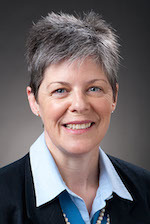Credit where credit is due: Rankings may miss up to 60 percent of UW-Madison publications
If every UW–Madison academician listed the university’s name as clearly as this pedestrian bridge over Park Street does, university officials say we would get wider credit for our research and rise in national rankings.
As automated rankings gain influence in the public view of universities, the computers may be missing a significant proportion of the University of Wisconsin–Madison’s intellectual output, says Jocelyn Milner, associate provost for academic planning and institutional research.
“Our full name is ‘University of Wisconsin–Madison,’ and articles can be missed if authors list something else, or only a particular institute or center with no further attribution,” Milner says.

Jocelyn Milner
In a 2013 study, Milner’s office found that only 38 percent of publications used “University of Wisconsin–Madison” or either of the other preferred variants (“Univ. of Wisconsin–Madison” and “UW-Madison”). Fifty-five percent used “University of Wisconsin,” and four percent omitted any reference to the university.
Other articles were marred by typos in the institution name or references to the non-existent “University of Madison.”
If as many as 60 percent of articles have a questionable institutional attribution, “increasing the count of publications by UW–Madison faculty by just 20 percent would substantially improve UW–Madison’s ranking among major research universities,” Milner says.
“In many cases, a human being could figure out that an author came from UW–Madison for any given article,” Milner says, “but rankings that include publication counts are computerized, and we doubt that the code is programmed to parse the hundreds of name variants we have found.” Even “University of Wisconsin” with a Madison address could go uncounted, she adds, as it could refer to the UW System Administration, UW Colleges or UW-Extension. “This creates a lot more opportunity for misattribution than ‘Harvard’ or ‘Stanford.'”
U-Multirank, an international ranking of more than 850 institutions, uses publication data (and patent listings, which could suffer from the same uncertainty), Milner points out. “This could explain why UW–Madison is ranked below average on publications per faculty member in U-Multirank comparisons.”
“Publications are increasingly counted in international rankings of research universities,” says Sara Lazenby, a policy and planning analyst who works with Milner. “Rankings are imperfect but they are a way for people outside the university to evaluate our impact. We have publications going unrecognized. We can do something that does not require any resources to help us get the recognition we deserve. Why would we not want to do that?”



